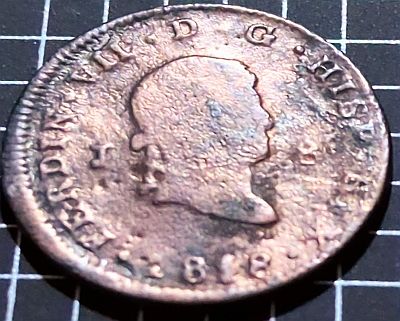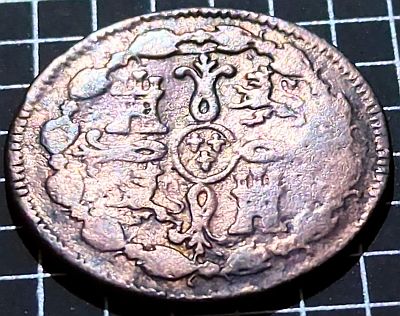A coin from The Desired, or the Felon King?
This is my entry for Day 19 “S” of the Blogging from A-Z April Challenge!
S = Spain.

Spain

Ferdinand VII swears on the 1812 Constitution before the Cortes in 1820, from Wikipedia.
Spain followed a similar path to many other European nations: Founded as far back as the Lower Palaeolithic period – up to 800,000 years ago, it came under the control of the Phoenicians, Greeks, Romans, Visgoths, and Muslim Caliphates, which brings us up to the 8th Century A.D. The Cordoba Caliphate had been weakened by ill-judged military aggressions, and fiscal pressure. This opened the way for the first Christian uprisings. By the 13th century, the four main Christian kingdoms of the Iberian Peninsula were formed: Portugal, Castile-Leon, Navarre and Aragon-Catalonia.
Queen Isabella of Castille, wife of Ferdinand II of Aragon united those Kingdoms which led to the eventual uniting of all of Spain. Isabella also funded Christopher Columbus on his journeys of discovery; she unleashed the Spanish Inquisition and decreed that all Muslims and Jews must convert or be expelled. This act of misplaced religious zeal destroyed what has been a society marked by remarkable religious tolerance and co-existence.
Like other European nations, Spain set out to create an empire. At the height of the Spanish Empire, it controlled 35 colonies that spanned every continent on earth except Australia and Antarctica. They controlled much of the Americas, including what today is Florida, in 1513, over 100 years before the Pilgrims landed at Plymouth.
Obverse

My piece is a bit worn, almost what I like to call a “Smoothie”, but still a good amount of detail (except in the portrait). The obverse features the portrait of Ferdinand VII, King of Spain in 1808 and again from 1813 to 1833. The King’s title is around the edge with date below. To the left of the portrait is the letter J, indicating this was minted in Jubia, Spain, a mint which was in operation from 1812 – 1868. The 8 to the right indicates the value, 8 Maravedis. At the time, Spain used the “Real”. 1 Real = 34 Maravedis and 1 Escudo = 16 Reales. Escudo were gold, Real were silver and Maravedis were copper.
Ferdinand VII came to power in March 1808, a few months after Napoleon Bonaparte’s troops entered the Iberian peninsula. Spain were initially allied with France’s plan to invade Portugal. Spain hoped to secure southern Portugal for itself. Napoleon betrayed Spain, and overthrew King Ferdinand VII in May 1808. Ferdinand VII and his father were imprisoned in France from 1808 – 1813, causing a crisis throughout the Spanish Empire. The struggle for independence from France was ultimately successful, but also led to independence of Spanish colonies in parts of Latin America.
The restoration of the Spanish monarchy wasn’t the last of Ferdinand VII’s troubles. While he had been known as el Rey deseado (the desired king) during his time as heir and brief early reign. Ferdinand VII was seen as incompetent and despotic. His loss of nearly all Spain’s American possessions caused a civil war upon his death. Despite his decade in exile, Ferdinand missed the opportunity to use the prestige he acquired as heir to modernise and regenerate the monarchy, thus ultimately entering history for failing to bring constitutional rule to Spain. Hence, his second nickname, el Rey felon (the felon/criminal king).
Reverse

The reverse of the coin is quite intricate, despite the wear on my example. It features the coat of arms of Castile and Leon. The arms of Castile (the yellow castle) quartered with the arms of León (the purple lion). These are inside a wreath, and each quarter of the arms are separated by decoration as well. The three fleur-de-lis in the centre represent the House of Bourbon, of which Ferdinand VII was a member.
What is your favourite well-worn coin? Do let us know! Share a picture on social media, I love to see other well-loved pieces.


Leave a Reply